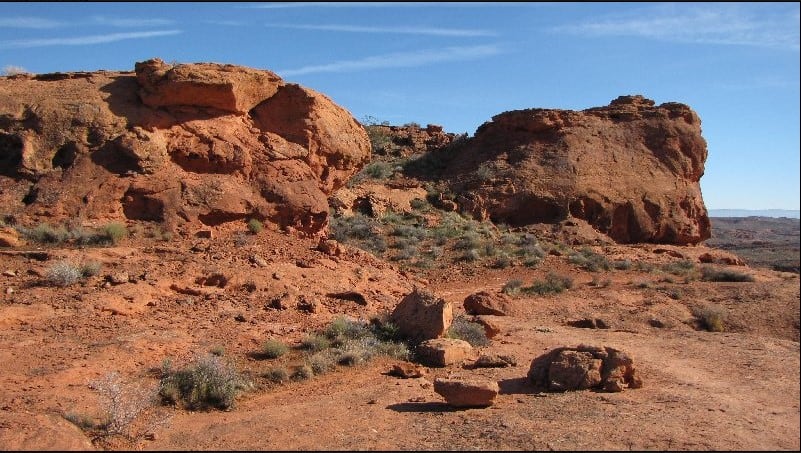Honeycomb weathering pattern in Kayenta Formation sandstone
Are you able to take time to ponder the natural world around you as you traverse the ridges and swales of each day? Do you look around and marvel at your surroundings – at nearby low rounded hills or distant jagged mountain peaks, at a nearby stream lazily meandering in its channel or swiftly cutting into its banks, at a V-shaped valley floor (or is it U-shaped?) that you pass by on your way to work every day, at those particular trees growing on that particular slope, at those rounded or maybe angular pebbles you find in your garden? Do you ever get to wondering – How did that get there? How did that happen? Why is that like that???
I surely do. I guess if I didn’t there would be no reason for me to spend so much of my time writing this blog.
The other day, as Sue and I were moseying in and out of the rocks on the Chuckwalla trail in the Red Cliffs Desert Reserve (see previous post), we came upon some very familiar structures in the sandstone. I know I’d seen them before as I wandered on desert hikes over the years, and also in rocks on the coast, and knew they were referred to as “honeycomb structures” or ““honeycomb weathering”. But how did they form? How did they get there?
Various sized cavities in sandstone
The two of us stood in the middle of the trail for a few moments, chewing on the various reasons we thought this weathering pattern might occur. Sue thought that wind was somehow involved. I thought that water had to have something to do with it. As it happens, we were both on the right track.
My Glossary of Geology being nowhere near at hand, I looked it up in the internet version of my old Funk & Wagnall – Wikipedia. Wiki-p has gotten a really bad rap over the years but I believe it is a good place to start investigating pretty much anything. You start by typing in the topic of your original inquiry – but then you might click on some intriguing link for an additional definition, and then another, and another – so that pretty soon you have forgotten what you were looking up in the first place. And then you find a totally new link to a relevant article and bookmark it to read when you have time. Or maybe you read it right then and there, soon realizing “Whoa! This is way more information than I need – but it is so interesting.”
But I digress. See what I mean? What was I talking about?
Oh, right. Honeycomb weathering. These fascinating natural cavities in the rock can range in size from miniscule pitting to caves the size of an 18-wheeler. They can be found in all climate types but are most common in intertidal areas as well as semi-arid and arid deserts.
So what do you suppose is the common denominator in these environments?
It appears to be salt.
Nice examples of honeycomb weathering
There are several current explanations as to why this phenomenon occurs (is there ever just one explanation for anything?). It turns out that Sue and I were both on the right track in our chewing – the salt is initially deposited on the rock by wind and/or water.
A saline, or salt, solution seeps into the cracks and joints of a porous rock such as sandstone. The water in the solution eventually evaporates, leaving the salt crystals to expand as they are heated and so causing the sandstone to break down grain by grain.
More examples of honeycomb weathering
This can be easily imagined to happen at the ocean. But what about any salt in an arid environment such as southern Utah? Around here, where does the salt come from? I expect it is found in the soil, derived from the chemical breakdown of rocks that contain sodium such as some feldspars (the most common rock-forming minerals on the entire planet). Also, salt deposits from the evaporation of ancient seas could find their way into groundwater, or be carried away by the wind from their source location.
I must find the article on the origin of honeycomb weathering that I discovered and bookmarked. It’s got to be here somewhere…






